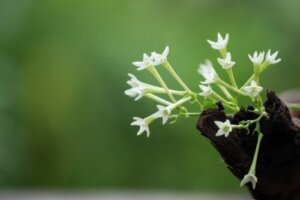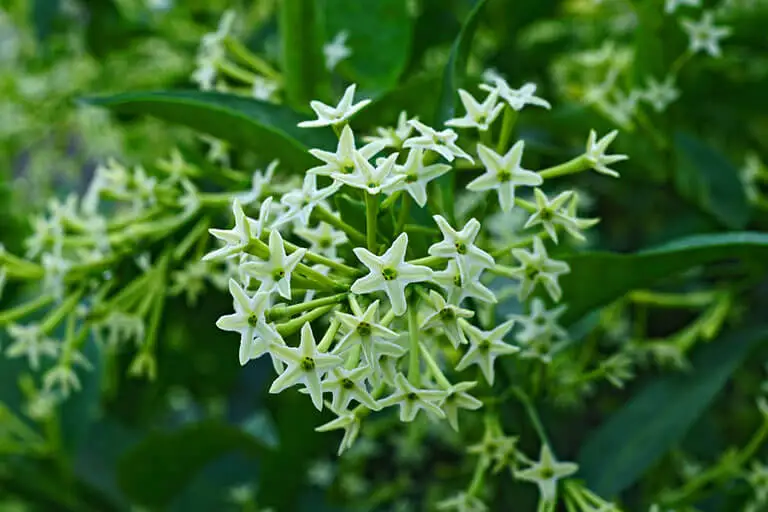Looking After the Lady of the Night Plant to Enhance Its Scent

The lady of the night is a very well-known shrub, thanks to the beauty of its tiny flowers and the sweet aroma they secrete when the sun goes down. And that’s how it gets its name. Although it must be said that it’s also known as “night blooming jasmine”, among other names.
Looking after it is very simple, but its basic care helps to maintain its general well-being and ensure that its aroma sweetens all your nights. If you want to know more about it, then read on.
Characteristics of the lady of the night
The scientific name of the lady of the night is Cestrum nocturnum and it’s a large shrub that can reach up to 5 meters (16.4 feet) in height. As its name indicates, it belongs to the genus Cestrum, and the Solanaceae family, to which the tomato and the potato also belong. Strange, isn’t it?
Its flowers are small compared to the body of the plant. They are white and produce its characteristic aroma; its leaves are green and oval-shaped.
It is a species native to tropical and subtropical regions of the planet, which can be planted indoors and outdoors. But this isn’t all. According to scientific articles, the plant has properties that could be useful in medicine:
- Analgesic: Capable of reducing pain, depending on the dosage used.
- Antifungal and antibacterial: Especially from the essential oil of the plant.
- Hepatoprotective: Especially the leaves, which were tested to counteract the adverse effect of paracetamol.
Most research with C. nocturnum is in animals or in vitro. Therefore, results can’t be transferred to humans quite as easily.

Read also: The 6 Best Medicinal Plants with Scientific Proof
The care you should give to your lady of the night
As we mentioned, the lady of the night is a perennial species that requires very basic care. However, this doesn’t mean that it should be neglected. The more you pamper it, the more beautiful it will look and the more enchanting its fragrance will be.
Take note of the recommendations we’ll give you to enjoy this shrub optimally.
1. Choose its position carefully
This shrub, as it comes from a tropical environment, doesn’t tolerate frost, and overly cold climates hurt it. The lady of the night must be protected from this climate, as well as from strong winds.
Thus, the ideal thing is to plant this tree in an area where it’s protected by a roof or the shade of larger trees if you have them. However, this location should also guarantee sufficient sunlight, as this is essential for its development. The hours of sun exposure are what guarantee that it will produce its sweet aroma.
2. Good drainage and moderate watering
Being a perennial species, the lady of the night isn’t demanding when it comes to the substrate. However, ideally, the substrate should allow it to drain the irrigation water so that it doesn’t become waterlogged and that its roots aren’t affected.
As for watering, it should be moderate. It should be watered twice a week during the winter and every other day during the summer. However, you should ensure there isn’t any excess water after watering, so water it slowly until you find the right amount.
3. Pruning and pest control
Pruning the lady of the night should be done at the beginning of summer, just after flowering. This is the best way to keep the tree under control, as it could overgrow and lose the desired shape. In addition, pruning at this time will ensure that a second bloom will occur at the same time.
Take the opportunity to remove dried and wilted leaves and flowers so as not to hinder the healthy growth of others and to avoid pests. This shrub is very susceptible to aphids, whiteflies, and spider mites. The cleaner it is, the better.
In case you see any of these pests, use some home remedies that don’t affect your plant or the soil.

4. Fertilize the lady of the night
The lady of the night can grow much better if you fertilize the soil from time to time. This will ensure that nutrients are available at all times. If you use fertilizers, opt for liquid fertilizers with a high concentration of iron, which will be appropriate for good flowering.
Discover more: How to Make Organic Bocashi Fertilizer
5. Propagating lady of the night
This plant can be propagated through its seeds or by cuttings. Regardless of the method, you should do it in late spring or early summer, just when it is about to start flowering.
While growing the seeds or rooting the cuttings, it’s necessary to keep the pot in partial shade and iata temperature that doesn’t exceed 20 degrees Celsius (68 Fahrenheit) for at least 3 weeks.
All cited sources were thoroughly reviewed by our team to ensure their quality, reliability, currency, and validity. The bibliography of this article was considered reliable and of academic or scientific accuracy.
- Amin Shaista y Parle Amrita. Delicate, fragrant, lady of the night- A medicinal gift. (2016). Journal of Medicinal Plants Studies; 4(6): 13-17.
- Huang, L., Zhang, X., Xiao, H., YE, H., & Zeng, J. (2006). Analgesic effect of Cestrum nocturnum L. extract on mice. Chinese Journal of Tissue Engineering Research, 172-174.
- Qadir, M. I., Al Murad, M. S., Ali, M., Saleem, M., & Farooqi, A. A. (2014). Hepatoprotective effect of leaves of aqueous ethanol extract of Cestrum nocturnum against paracetamol-induced hepatotoxicity. ||| Bangladesh Journal of Pharmacology|||, 9(2), 167-170.
- Rashed, K. N., Ćirić, A., Glamočlija, J., Calhelha, R. C., Ferreira, I. C., & Soković, M. (2018). Identification of the bioactive constituents and the antibacterial, antifungal and cytotoxic activities of different fractions from Cestrum nocturnum L.
This text is provided for informational purposes only and does not replace consultation with a professional. If in doubt, consult your specialist.








